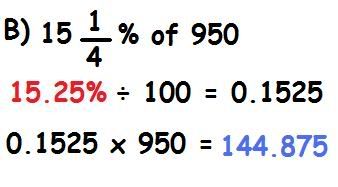
Part A







This is a place for the community of learners in Room 8-16 to learn and enjoy math. It is an extension of the classroom making it accessible 24 hours a day, 7 days a week.














 ( click image )
( click image ) ( click image )
( click image ) ( click image )
( click image )


14. a) If 200 squares were used instead of 100 squares to represent 100%, how would you show 0.25%?
b) If 400 squares were used instead of 100 squares to represent 100%, how would you show 0.75%?
(My scanner stoped working after that last scan so i just took this picture from mytextbook.ca)
a) If we used 200 squares instead of 100 we would need to double the numerator because the denominator (100) was doubled so when representing what would normally appear as 1/4 would now appear as 1/2 but still be equal to 1/4.
b) If we used 400 squares instead of 100 we would need to quadruple the numerator because the denominator (100) was quadrupled so when representing what would normally appear as 3/4 would now appear as 3 but still be equal to 3/4.
.png)
And that was my (slightly late) scribepost I hope it was informative.

 The Siberian Tiger would be 0.13%
The Siberian Tiger would be 0.13% The length of the Yukon river is 230%.
The length of the Yukon river is 230%. For example if we had to shade in 65% of the grid we would shade 65 squares. Why? because percents are out of 100. We also had to show if we messed with a square so then we just make some sort of pop out to show what we did.
For example if we had to shade in 65% of the grid we would shade 65 squares. Why? because percents are out of 100. We also had to show if we messed with a square so then we just make some sort of pop out to show what we did. .
.


~~~~~~~~~~~~~~~~~~~~~
Question : Purple
What is the minimum distance the player
at third base has to throw the ball to get
the runner out at first base? Express your
answer to the nearest tenth of a metre
Okay, soo we need to find the hypotenuse
a²+b²=c²
27m²+27m²=c²
729m²+729m²=c²
1458=c²
√1458=√c²
c=38.18m
The shortest distance the 3rd basemen would have to thorw would be 38.18 meters.






© Blogger templates Psi by Ourblogtemplates.com 2008
Back to TOP